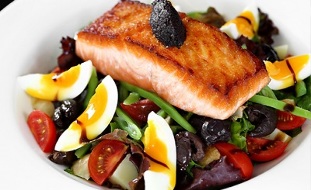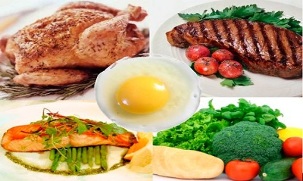How many times have you had to re-read a number of highly effective diets that help get rid of subcutaneous fat? Do you know why there are more than 10, 000 opportunities in the world for various activities to lose weight? Simple: because 90% of them are ineffective. A protein diet for weight loss is a good option, but it can also be ineffective if used incorrectly. How can proteins be used for weight loss without compromising health with maximum results?
How to lose weight on a protein diet?
To get rid of subcutaneous fat, you need to know your body’s physiological needs, understand when to take carbs and when to consume protein, and be able to listen to your body giving an unlimited number of prompts, in case youwe are malnourished.
Surely most of you already know that by limiting your intake of sweet and complex carbohydrates, significant weight loss can be achieved, the specific value depends on the percentage of fat in the human body. This can be called a low carb diet, which is a very effective way to get rid of fats. The caloric deficiency created by minimizing carbohydrate intake can be completely replaced by fat. That’s why people lose weight by limiting the use of carbs in their diet.
What happens if carbohydrates are completely excluded from the diet?
Will there be a better way to lose weight? Our answer is yes, of course. This diet was especially popular in the golden age of bodybuilding and was widely promoted by Vince Gironde. Just look at your photo and you’ll immediately see why you recommended it. Its name is one of the best, according to many nutritionists, effective fat burning methods are a protein-rich diet.

A protein weight loss diet is a carbohydrate-free diet that consists only of protein foods and healthy fats for the body. Carbohydrate calories are fully compensated by animal protein. This approach not only allows for the most effective release of fat, but also speeds up metabolism and preserves muscle tissue as much as possible.
Many diets virtually ignore the latter two aspects: their main goal is to simply reduce their total daily caloric intake, which does not have a very positive effect on the condition of a dieting person.
A sudden drop in caloric intake is considered life-threatening, the body begins to slow down its metabolism, and transports all the food it consumes subcutaneously into fat, using muscle fibers to consume energy. So it turns out that at the end of this method of weight loss, a person creates ideal conditions for fat gain and does everything he can to burn muscle mass. Hopefully you have now lost your desire to try the famous mono diets?
Principles of protein content
If we create an environment in which carbohydrates are completely lacking, ketone bodies, the main source of energy for the brain and nervous system, begin to be released from subcutaneous fat.
To make it clearer, it should be explained that each food consumed contains more or less three nutrients, each with its own life-sustaining function. These are fats, proteins and carbohydrates:
- The
- proteinis the building block of our body, as energy is used in extremely rare cases.
- fatis stored energy that is stored for emergencies and fat is also used to protect internal organs.
- carbohydratesare fully responsible for the energy supply of our bodies.
Now it's clearer why we want to eat sugary or complex carbs when we're hungry? Because carbohydrates are the main sources of energy for our bodies, and proteins and fats remain in reserve. That’s why you want to eat so many sweet and complex carbs in your daily life: this is the most effective way to provide your body with energy. And that’s why people don’t like to exclude foods that contain carbs from their diet. The body does not understand that a person intentionally excludes the main source of energy. Your body thinks you are living in difficult living conditions and hunger is expected. If carbohydrates do not start flowing as soon as possible, the body will be forced to unload emergency fat reserves.
What happens if you continue to limit your carbohydrate intake?
First, your body uses up all of its glycogen stores, which lasts for a short time, and only then does it switch to a fully autonomous diet due to proteins and fats. A protein diet contains a number of positive reviews from people who have achieved incredible results thanks to this method of weight loss. To be honest with you, everyone in the world of diet establishes the protein method of weight loss. Read the mono-diet carefully and you will see between the lines the basics we cover in our article. Of course, if the author of the diet you are going to read presented it correctly.
It is important to add the important point that if we leave about 50 grams of carbohydrates on a rigid protein diet, one’s blood sugar levels will not rise. This means that the body continues to feed on adipose tissue in order to maintain a positive energy balance in the body.
Should you stop eating carbs on a high-protein diet?
This conclusion has many pros and cons. On the plus side, the complete elimination of carbohydrates leads to a rapid depletion of glycogen stores, and this forces the body to start using fat stores as soon as possible. And the reason for all this is our old insulin friend. Its presence or absence determines what energy the body will spend. Here, everything is simple: the less carbs you eat, the less insulin you secrete. Overvoltage of this hormone completely blocks the process of lipolysis (the breakdown of adipose tissue). It can be seen that a protein-rich diet eliminates insulin overvoltage and activates the full effect of lipolysis.
What are the main disadvantages of a protein diet?
In order to maintain the normal functioning of the digestive system, is it necessary to consume fiber, at least occasionally, where is it located? That's right, in carbs. Failure to do so can lead to problems such as constipation, which is completely unpleasant news. Therefore, we strongly recommend that you do not exclude vegetables such as cucumbers, tomatoes and cabbage in your protein diet. The gastrointestinal tract remains fully functional.
Harm of a protein diet
The harm of a protein diet can only occur if you start consuming excessive amounts of protein and completely exclude fiber from your diet. And these operations are applied for a long time and then the body malfunctions begin. We strongly recommend that you consult your doctor and dietitian before using the above system. Because there is a significant list of diseases in which the use of only protein foods is unacceptable. Good health to everyone and eventually you can become the owners of the most charming figure in the city.
How long does the protein content last?

- It is possible to have a constant diet: for a long time you only consume proteins, healthy fats and fiber. The
- Strength Dietcan only be used on training days. About two hours before your workout, you do a carbohydrate load to provide glycogen and significantly increase your workout intensity. Every other day is a protein diet.
- Cyclical use of a protein diet. This option provides once a week carbohydrate load during the day. This helps maintain maximum muscle mass and further boosts your metabolism. So we recommend that you use it for anyone who wants to make their body worthy of their spirit. Although you can experiment and choose the most suitable option for yourself.
What to eat with a protein diet: food
Probably the answer won’t come as no surprise when you say that these should be foods that contain animal protein. It is best to use lean meats such as veal, beef, chicken breast and rabbit. From dairy products, choose foods that are not high in fat, but you should not consume only low-fat kefir. The fat content is up to 10%. This is normal, no need to worry. - Remember, fats burn in carbohydrate fires. Be sure to eat fish: not only is it high in protein, it is also a source of healthy omega fats. Don’t forget about eggs as a measure of all assimilation among the above products.
There should be 5-10 meals a day, in fact, the better, the better. That’s why every meal should be prepared in the morning and evenly distributed in the bowls: this allows you to open a bowl of food at any time of the day and consume the required amount of food.
Sample menu for the week
This is what a 7-day protein diet menu might look like, or it could be extended by 14 days.
Monday
- fat-free cottage cheese packaging;
- glass of yogurt, 1 grapefruit;
- 2 chicken breasts, broccoli, half a glass of kefir;
- a bottle of yogurt, grated medium carrots;
- 1 liter of carbonated mineral water, a glass of natural apple juice.
Tuesday
- yogurt, green apple;
- 100 g of meat, cheese, tomatoes, 1 bell pepper;
- 200 g of fish, salad with celery, carrots and ½ apples;
- 2 hard boiled eggs, cabbage salad with parsley and lemon juice;
- 1 liter of water, 1 glass of currant juice.
Wednesday
- yogurt, a glass of strawberries;
- granular cottage cheese with a spoonful of chopped parsley, red pepper and tomato puree;
- 2 chicken breasts, one cup of spinach, half a cup of kefir;
- any roasted, zucchini, 1 tomato, 2 tablespoons dill (we can mix vegetables and add 2 tablespoons olive oil), 2 slices of ham;
- 1 liter of water, a glass of orange juice.
Thursday
- fat-free cottage cheese packaging;
- a glass of kefir, ½ glass of raspberries;
- 200 g of stew, 1/3 cup milk, carrots;
- 2 eggs, cabbage salad with paprika and parsley flavored with lemon juice;
- 1 p. water in a glass of currant juice.
Friday
- yogurt, 2 tangerines;
- granular cottage cheese (1 pack);
- 200 g of sea fish, tomato, red pepper and parsley salad, yogurt;
- granular cottage cheese (1 pack), carrots, green apples;
- 1 liter of water, a glass of orange juice.
Saturday
- 100 g of cottage cheese, skimmed milk;
- a glass of kefir;
- 2 chicken breasts, beans, yogurt;
- 2 slices of ham, broccoli, 1 egg, 2 tablespoons corn;
- 1 p. water in a glass of currant juice.
Sunday
- a glass of kefir, ½ glass of raspberry (or other berry);
- granulated cottage cheese, slices of ham;
- braised chicken liver, salad with lemon juice, apple;
- yogurt with added fruit;
- 1 liter of water, a glass of apple juice.















































































